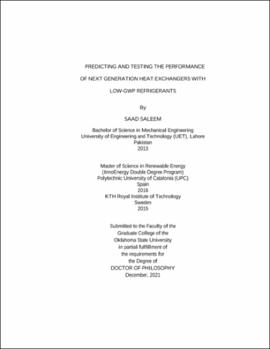| dc.contributor.advisor | Bradshaw, Craig R. | |
| dc.contributor.author | Saleem, Saad | |
| dc.date.accessioned | 2022-05-13T15:26:28Z | |
| dc.date.available | 2022-05-13T15:26:28Z | |
| dc.date.issued | 2021-12 | |
| dc.identifier.uri | https://hdl.handle.net/11244/335734 | |
| dc.description.abstract | Energy efficiency regulations are forcing air conditioning (AC) and heat pump (HP) manufacturers to replace existing high global warming potential (GWP) refrigerants in their systems with more climate friendly alternatives. Air-to-refrigerant fin-and-tube heat exchangers (FTHXs), and water-to-refrigerant coaxial heat exchangers are commonly found in residential and commercial AC and HPs. To adapt to these new refrigerants, heat exchanger manufacturers need to make design changes in their equipment, in order to ensure that the next generations of their products is energy efficient, climate friendly, and cost effective. This thesis aims to develop a set of guidelines for pseudo-optimal design of FTHXs in order to accommodate the next generation of low-GWP refrigerants, with the goal to obtain near optimal performance under current manufacturing constraints. | |
| dc.description.abstract | A novel pumped refrigerant loop was developed, and coupled with an airside setup and a psychrometric chamber facility, to test FTHXs. The experimental facility was used for validating a segment-by-segment heat exchanger model called cross-fin (Xfin), by comparing model predictions against data collected from three custom designed FTHXs with distinct refrigerant circuitries. The mean absolute percentage error (MAPE) between the experimental, and model predicted capacities was found to be 1.0%, 2.4%, and 0.9%, for the interleaved, vertical, and block circuited FTHXs, respectively. A preliminary simulation study was performed using a four-component HP model to investigate the change in system performance metrics of an R410A based water-to-water HP, using R454B and R452B as low-GWP 'drop-in' alternatives. A four-component heat pump model, validated against the performance datasheet, was used for simulations and showed that some design changes may be necessary to existing equipment, in order to adapt them for near optimum performance with low-GWP fluids. Then, Xfin model predictions were compared against experiments performed on the block circuited FTHX with R1234ze(E). The MAPE between the experimental and model predicted capacities was found to be 1.4%. A parametric simulation study was done by modifying the refrigerant circuitry and fin pitch, showing that FTHX performance metrics such as capacity (Qevap) and refrigerant pressure drop ([Delta]Pref), are influenced by changes in geometry. Finally, simulations were executed to compare the performance of R1234yf and R1234ze(E) on the R410A based block circuited indoor evaporator FTHX. It was found that the performance, in terms of the ratio Qevap/[Delta]Pref, was most sensitive to the number of circuits, followed by the tube diameter, number of tubes in the FTHX, and the fin density. Based on the simulation results, two customized FTHX designs were suggested, with different changes to the FTHX slab size. One design prioritized increased FTHX capacity, and the other prioritized reduction in refrigerant pressure drop to acceptable limits. | |
| dc.format | application/pdf | |
| dc.language | en_US | |
| dc.rights | Copyright is held by the author who has granted the Oklahoma State University Library the non-exclusive right to share this material in its institutional repository. Contact Digital Library Services at lib-dls@okstate.edu or 405-744-9161 for the permission policy on the use, reproduction or distribution of this material. | |
| dc.title | Predicting and testing the performance of next generation heat exchangers with low-GWP refrigerants | |
| dc.contributor.committeeMember | Bach, Christian K. | |
| dc.contributor.committeeMember | Spitler, Jeffrey D. | |
| dc.contributor.committeeMember | Shah, Jindal | |
| osu.filename | Saleem_okstate_0664D_17430.pdf | |
| osu.accesstype | Open Access | |
| dc.type.genre | Dissertation | |
| dc.type.material | Text | |
| dc.subject.keywords | heat exchangers | |
| dc.subject.keywords | hvac&r | |
| dc.subject.keywords | low-gwp fluids | |
| dc.subject.keywords | refrigerants | |
| thesis.degree.discipline | Mechanical Engineering | |
| thesis.degree.grantor | Oklahoma State University | |
